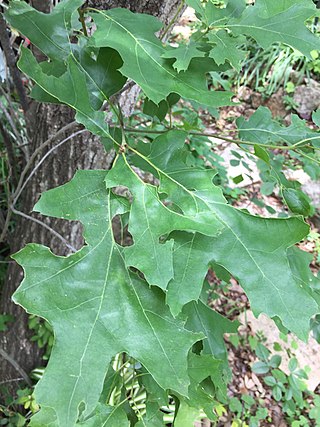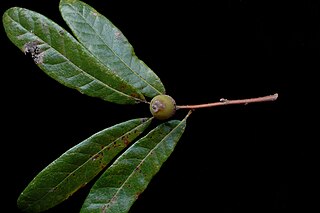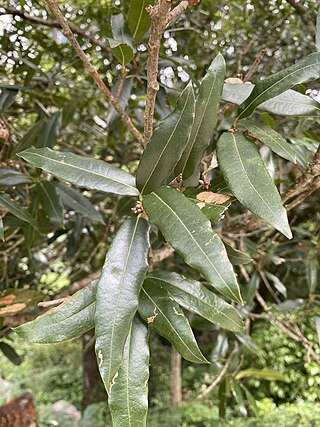
The Zagros Mountains forest steppe is a temperate broadleaf and mixed forests ecoregion in Western Asia. The ecoregion extends along the Zagros Mountains, stretching from eastern Turkey and northern Iraq to southern Iran.

Quercus acerifolia is a rare North American species of oak in the red oak section of Quercus. It is endemic to just four locations within the Ouachita Mountains of the State of Arkansas.

Quercus buckleyi, commonly known as Texas red oak, Buckley's oak, or Spanish oak is a species of flowering plant. It is endemic to the southern Great Plains of the United States.

Quercus conzattii is an oak endemic to Mexico. It is placed in Quercus section Lobatae.
Quercus depressa is a species of red oak endemic to Mexico, including the states of Hidalgo, Oaxaca, Puebla, and Veracruz.
Quercus macdougallii is a species of plant in the family Fagaceae. It is placed in section Quercus.

Quercus oglethorpensis is a species of plant in the beech family. It is endemic to the United States. It is named for Oglethorpe County, Georgia, where it was first discovered. The county, in turn, is named for James Oglethorpe, the founder of Georgia Colony in the 18th century.

The Trans-Mexican Volcanic Belt pine–oak forests is a subtropical coniferous forest ecoregion of the Trans-Mexican Volcanic Belt of central Mexico.

Quercus polymorpha, the Mexican white oak, Monterrey oak or netleaf white oak, is a North American species of oak. It is widespread in Mexico, Guatemala, and Honduras, and known from a single population in the United States but widely planted as an ornamental.

Quercus john-tuckeri is a North American species of oak known by the common name Tucker oak, or Tucker's oak. It is endemic to California, where it grows in the chaparral and oak woodlands of mountain slopes in the western Transverse Ranges, the southernmost Central Coast Ranges, and the margins of the Mojave Desert. The species is named after John M. Tucker, professor of botany (1947–1986) at the University of California at Davis, specialist in Quercus.

Quercus paxtalensis is a species of oak endemic to Mexico.

Quercus pinnativenulosa is a species of oak endemic to Mexico.
Quercus flocculenta is an endangered species of oak in the family Fagaceae, native to northeastern Mexico. It is endemic to the Sierra Madre Oriental of Nuevo León state.
Quercus edwardsiae is a species of oak endemic to northeastern Mexico.
Quercus tuitensis is a species of oak. It is endemic to the Sierra el Tuito of Jalisco state in western Mexico.
Quercus tinkhamii is a species of oak endemic to the Sierra Madre Oriental of eastern Mexico.
Quercus aculcingensis is a species of oak endemic to eastern Mexico.
Quercus chrysotricha is a species of oak endemic to Borneo, where it is known only from Mount Dulit in Sarawak. It is placed in Quercus subgenus Cerris, section Cyclobalanopsis.
Quercus kerangasensis is a species of oak native to Borneo. It is placed in Quercus subgenus Cerris, section Cyclobalanopsis.
Quercus percoriacea is a species of oak endemic to Borneo, where it is known only from northern Sarawak state of Malaysia. It is placed in Quercus subgenus Cerris, section Cyclobalanopsis.










